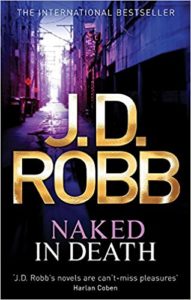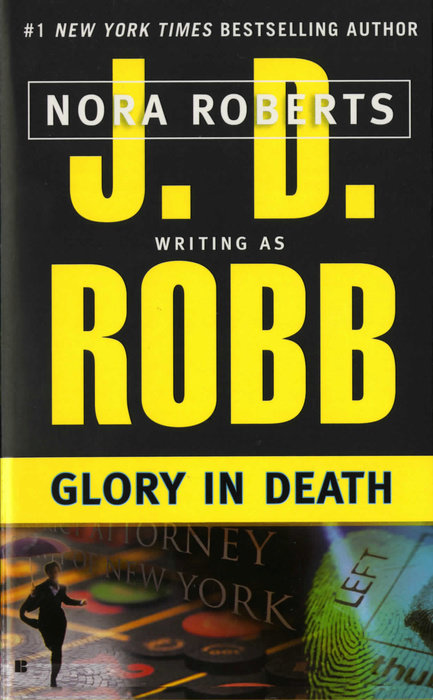 So, back around the turn of the year, several of our contributors here at Speculative Chic made New Year’s Resolutions, committing to movies or books or authors that, at some point, they’d given short shrift, or moments in pop culture that had passed them by. At the time, I was at a loss for my own resolution.
So, back around the turn of the year, several of our contributors here at Speculative Chic made New Year’s Resolutions, committing to movies or books or authors that, at some point, they’d given short shrift, or moments in pop culture that had passed them by. At the time, I was at a loss for my own resolution.
But that was because I forgot about In Death!
Let me start with a little background for those of you who might not be familiar with the In Death series. In 1995, Nora Roberts, under the pseudonym J.D. Robb, published Naked in Death, a book that turned out to be the first in a futuristic, hard-boiled thriller series that, as of September 4th of this year, will be up to the forty-seventh title. No, you didn’t read that wrong. Published at a pace of two books a year since 1995, there will be forty-seven books by the end of 2018, and at the moment, Roberts has yet to show signs of slowing down or stopping.
Keep in mind, this is on top of all the books Roberts has published under her own name. Stephen King might be known for being prolific, but he ain’t got nothing on Roberts. That woman is a machine! And I mean that in a good way. There are those who might argue that with that number of books, the quality must lag at some point, but check out Roberts’ and Robb’s review scores online. She has legions of readers and reviewers, and for the most part, they seem pretty darn happy.
I digress. We’re not here to discuss Roberts’ prodigious backlog, except when it comes to her In Death series. For the record, I’ve never read a Nora Roberts book before. Not on purpose or anything; she just happens to be an author into whose oeuvre I haven’t delved. But I’ve always been aware of the In Death books, and I’ve almost picked them up a dozen different times. They tick off a lot of the items on my personal Want to Read List: a long series to catch up on, a female protagonist, mysteries aplenty, set in the future. I mean, we’re talking forty-seven books, all with the same protagonist—Eve Dallas, an officer in the New York City Police and Security Department (aka NYPSD), they feature her with the same boyfriend-turned-husband Roarke, and they’re set in the middle of the twenty-first century. The question isn’t why I want to read these books, but why I haven’t picked them up sooner?
But are these books sci-fi heavy enough to qualify as speculative fiction? In the early books, the plots certainly rely more heavier on the hard-boiled mystery/thriller angle than they do on the technology. However—keeping in mind that I’m only a book and a half into the series (Naked in Death is followed by Glory in Death)—I would say yes. And here’s why: science fiction isn’t so much defined by the progress of technology as it is the progress of ideas.

Sure, there are classic futuristic markers that you could find in any number of sci-fi stories, TV shows, movies, etc.: flying cars, phasers instead of old-school guns, voice-activated home systems, face-to-face telelink communication.
Of course, since the first book was published in 1995, some of these “futuristic” items have already come to fruition and now seem charming in their antiquity. But it’s not just the technology that gives Robb’s series its progressive edge. There are observations about violence and gender and sex and politics that feel not just relevant but revelatory.
Dallas doesn’t fit the classic hard-boiled detective mold, and not just because she’s a woman. Yes, she has a dark past, and of course, there are times when the job wears her down, but she’s not so jaded that she’s beyond caring about her victims, and she’s not so hardened that she’s beyond growth or change. She has friends, both male and female, and a long-term mate.
Not that Robb’s every attempt at creating a vivid future hits the mark. It’s mentioned in the first book that’s there’s been an overall melding of the races, creating a certain homogeneity to skin color, hair type, etc. Dallas, however, is on the paler end of the spectrum, as is her lover. And in book two, there’s a very jarring reference to a character being “full black.” He calls out to Dallas with a rude “Hey, white girl,” and she replies with what’s described as an equally rude, “Hey, black boy.” I think I get what the author was going for—an enlightened time period in which any blatant mention of race is considered an insult. Problem is, without further context, it falls flat on its face.
 But more often than not, Robb’s glimpses into the future are positive. There seem to be an equal number of men and woman on the police force. Sexual harassment in the workplace is a nonissue. Roarke values Dallas for her intelligence and strength just as much, if not more, than for her good looks.
But more often than not, Robb’s glimpses into the future are positive. There seem to be an equal number of men and woman on the police force. Sexual harassment in the workplace is a nonissue. Roarke values Dallas for her intelligence and strength just as much, if not more, than for her good looks.
I’m curious to read this series for a number of reasons. One, I’m curious if I can finish all forty-seven books by the end of the year. Two, I wonder if/how the technology in the book will change along with the time periods in which they were published. (Will Robb move parallel to our timeline or make even wilder leaps to stay ahead of the ever-growing curve?) Three, I’m desperate to figure out their monetary system, which seems to consist of bills, coins, cards, chips, and several other means of payment. Finally, I want to see how Robb’s ideas continue to grow and evolve, and just what has kept her readers wanting more after twenty-three years.
Because forty-seven individual book reviews seems like a bit of overkill, I’ll be posting reviews every ten books or so. Unless a particular book really stands out, in which case, it might just get its own post.
Featured image of Science World at Telus World of Science in Vancouver, Canada. The ideal vision for Robb’s futuristic city.

Enjoy! I liked some “In Death” books more than others, but they have all been good reads. I hope you’ll have fun on your journey with Eve, Roarke, and company!
Thank you! I’m four books in now and have enjoyed them all so far!
I’m waiting eagerly for you to convince me to read them! I’ve read a couple and enjoyed them, but enough to actively seek them out??
I’ll do my best!